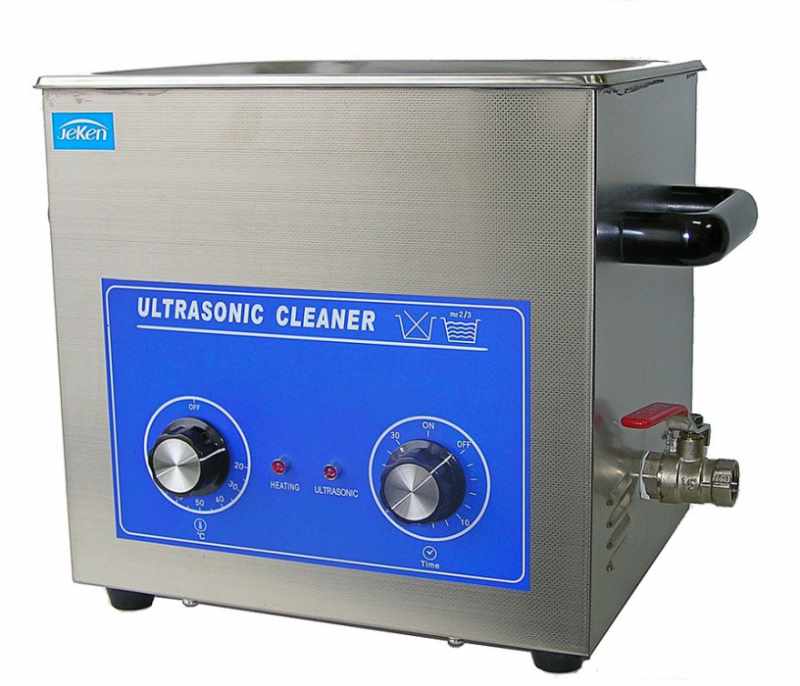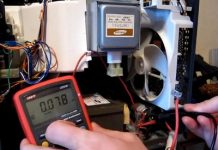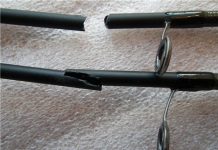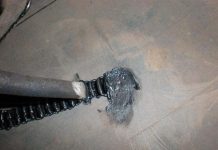Self-repair of the mechanism includes a preliminary visual inspection. Surface analysis begins with checking the cable for breakdowns, the absence of fluid leaks and rumblings inside the case, after which it is necessary to check:
Diagnostics of a specific unit can be performed independently, the best will be the ability to install a failed element on another device. Some instructions describe how to carry out maintenance consistently, it is better to follow the manufacturer's recommendations for safe operation and quick effect.
An ultrasonic bath, which you can make with your own hands, will help to clean objects from rust, dirt, and plaque. To do this, you must have a certain amount of materials and strictly follow the rules of the device manufacturing technology. This is a fairly simple device that allows you to quickly and effectively get rid of contamination on various parts, assemblies and tools. The device is used for products, cleaning of which is strictly prohibited by mechanical means.
An ultrasonic bath is a container made of alloy steel with a standard volume of 2 liters, which allows you to place several small items there at a time. For work on an industrial scale, baths of 10 and 15 liters are used.
The operation of the device is based on the effect on the parts of ultrasound, the vibration frequency of which exceeds 18 kHz. After turning on the mechanism, the liquid poured into the container is filled with a large number of bubbles under the action of generation. The formed molecular air balls tightly envelop the submerged product, attract dirt, and burst under pressure. The use of this technology allows you to clean the most inaccessible places for manual processing. At the same time, the integrity of the surface and the structure as a whole is not damaged.
If it enters the container, any element covered with a dense layer of corrosion is easily cleaned of rust.
There are three elements in the design of ultrasonic devices. The emitter is the main mechanism. It converts electrical current fluctuations into mechanical ones, which, when they enter the liquid, act through the walls of the container on the item to be cleaned.
The emitter operates in a pulsed supply system, it is very important to monitor the stability of conditions in the intervals between shocks. The entire process is under full control. Depending on the complexity of the contamination, it is possible to set the desired time, frequency and degree of exposure.
Some designs do not include the last structural component.
Ultrasonic baths are widely used in many areas of industry.The demand for devices is due to obtaining a more effective result in comparison with traditional cleaning methods.
Car service employees use an ultrasonic bath when flushing injectors, carburetors, filters, nozzles. When repairing computer equipment and mobile phones, such devices have established themselves as the most effective mechanisms. They are used to remove flux build-ups from the smallest parts. It is advisable to remove plaque from all types of bathroom faucets, metal fixtures to them.
Compared to other devices, the circuit of an ultrasonic bath, which can be drawn up provided that you know the basic basics of physics and electronics, has a number of advantages. The device is quite simple to operate, for operation you just need to fill the container with a special liquid and you can start the cleaning process.
All items are cleaned with soft liquid products that do not contain abrasive and aggressive substances. Therefore, the integrity of the parts remains intact.
Before buying an ultrasonic cleaner, you need to decide on the purpose of using the device. This will determine not only the volume of the container, but also the price of the device. The most expensive options for machining large parts can be equipped with automation systems and touch controls.
When choosing a mechanism that is suitable in terms of functions and characteristics, the presence of a heating device in the design should be taken into account. It helps to achieve better results. Moreover, if the liquid contains disinfecting components, there is no need for constant support and heating of temperature indicators. It is also important to understand what the size of the items to be processed will be. The larger the elements, the larger the bath capacity should be.
For ease of use, you can purchase an ultrasonic device equipped with a timer. This option costs a little more, but it allows you to control and set a certain time during the procedure.
It is worth noting: during operation, experts recommend using special baskets and glasses. When immersed, this will provide reliable protection of the container from mechanical damage.
You can buy an ultrasonic bath or assemble it yourself. In order to independently design a cleaning device, you need to decide on a list of materials and carefully study the manufacturing technology, which is shown in many videos on the Internet. To mount the device you will need:
You also need a liquid for an ultrasonic bath, which will be used in the future.
VIDEO
With all the parts and materials available, you can start the manufacturing process. Work begins by winding the coil onto a glass or plastic tube.In this case, the ferrite rod should hang freely, it does not need to be rigidly fixed. A magnet is attached to the end of the rod. As a result of the work, a design of a magnetostrictive transducer or emitter is obtained.
Holes are drilled in the bottom of a ceramic or porcelain vessel. They are required to insert a prefabricated emitter. After that, the vessel is fixed in the container. Next, you need to attach the pipes for supplying and draining the liquid.
It is worth noting: the solution for ultrasonic baths flows better and faster with a built-in pump.
A pulse transformer provides more efficient operation of the device by raising the voltage. The device can be removed from an old TV or computer.
After assembly, they proceed to the experimental launch of the device. If a malfunction is detected, it can be eliminated immediately. In this case, the following rules must be taken into account:
before starting, carry out an external inspection of the device;
it is impossible to work with the unit in the absence of liquid - this can lead to the rupture of the rod into pieces;
it is forbidden to touch the items that are in the vessel during the cleaning process with your hands.
Ultrasound requires extreme caution while respecting electrical and fire safety regulations.
Do-it-yourself ultrasonic bath: its structure and principle of operation. Where is ultrasonic treatment applied? Assembling an ultrasonic cleaner at home in 7 steps + 3 operating rules.
With technological progress, our homes began to be filled with everyday items, which greatly simplify life. Some equipment, which was previously used only in industrial conditions, is made more compact and adjusted for the use of an ordinary consumer.
You can bring a piece of progress into your home yourself.
DIY ultrasonic bath will save finances and bring great benefits to the farm.
Extend the life of washing machine components? Or remove plaque from precious metals?
It would seem that a not so popular design earlier can become an indispensable assistant in absolutely any business related to cleaning from scale and traces of corrosion.
The main component of the ultrasonic bath is the converter of electrical energy into mechanical energy. Ultrasonic waves propagate over the entire area of the vessel, which act on the submerged object.
Ultrasonic wave - sound frequency, not audible. It is in the range of 17 - 118 kilohertz.
To obtain such a range, a special frequency converter .
At the input, with the help of the action of electricity, the level of frequency fluctuations is reduced to ultrasonic. It is they who affect the destruction of the results of the corrosion process.
Well, to increase efficiency, it is used a heating element , which is located under the base containers made of stainless steel with a radiator .
Taken together, the three elements considered make up a circuit capable of impulsively acting on a submerged object and purifying it.
A do-it-yourself ultrasonic bath or a purchased one works according to the same principle. Waves affect the structure and break down elements with a weak crystal lattice. Rust, scale, plaque - substances that fall under this category.
To clean with an ultrasonic cleaner, you need:
Pour a special cleaning liquid into a stainless steel tank.
Place the item in the solution.
Switch on the ultrasonic cleaner.
If small bubbles began to appear periodically on the surface, this is a sign of successful work.
Withdraw the item after 3-10 hours in the solution.
The length of time the part is in the liquid depends on the degree of its initial contamination. If the scale is as thick as your finger, it may take more than 5 hours to clean.
The bubbles that are released in the ultrasonic bath gradually "eat up" the particles of corrosion on the object placed in the composition. A big plus is the ability to clean even the most inaccessible places, which is almost impossible to do with your own hands.
Today the scope of application of ultrasonic baths is very wide.
Areas of application of ultrasonic baths:
Plaque on gold and silver is removed within 20 - 40 minutes.
Small private repair offices often keep a similar structure, which in 60% of cases is made by hand.Optics .
The components of optical devices on an industrial scale are also susceptible to the corrosion process.
Cleaning in an ultrasonic bath is the safest and fastest method to restore the functionality of parts.Electronics .
Boards for portable and other equipment are very fragile, therefore mechanical processing will only harm them.Chemistry .
Acceleration of some chemical reactions due to exposure to ultrasonic treatment.Printing and automotive industry .
Cleaning all metal parts from signs of aging.
At home, you can use an ultrasonic bath to clean the elements of household electrical appliances and extend their life. The method will be most useful for heating elements of washing machines, which constantly suffer from limescale.
The advantages of cleaning in an ultrasonic bath:
When cleaning with your own hands, all the time is spent on direct interaction with the object.
In our case, it will be enough to put the part in an ultrasonic bath and turn on the device.You do not harm your health .
A direct contract with active chemicals is reduced to 2 - 3%.
If you are careful and use rubber gloves, then you will be 100% protected.Cleaning hard-to-reach places .
Small cracks or even microcracks where dirt could get through - nothing can avoid the action of ultrasound.No mechanical damage after processing .
Unlike mechanical stress, the risk of causing the part to malfunction during ultrasonic cleaning is reduced to zero.
The area of application of ultrasonic baths is very wide not only on an industrial scale, but also in households.
Although this item is not so common in our country, it can be found on specialized websites for the sale of household appliances.
What if there is no desire to spend extra 5000 - 8000 rubles about household utensils that are not used very often?
The solution will be a do-it-yourself ultrasonic bath. How much it will cost you, and what benefits from this - we will analyze below.
First, let's figure out how much a ready-made ultrasonic bath will cost you.
Depending on the purpose of use, you can purchase a portable version or an extended version. Entrepreneurs who run auto repair shops often buy such equipment for cleaning car parts (nozzles, valves, etc.).
By volume, ultrasonic baths are divided into:
Portable. * Small devices with a capacity of 1 - 2 liters. The best option for home use.
If you have your own workshop, you can order additional options for 20 - 30% of the final price.
Industrial.
* Used in specialized enterprises.
Prices for ultrasonic baths across the country jump from 4,000 to 20,000 rubles for portable ones and within 15,000 - 40,000 for their industrial counterparts. For a minimal price, you will receive a standard unit with a minimum of additional functions.
Do-it-yourself ultrasonic cleaner assembly can cost you 2 - 3 times cheaper. The main thing is to have basic skills in owning a soldering iron and find the right materials.
What if you need to clean large agricultural parts such as a tractor or combine?
Spending 50,000 rubles for 3 - 4-time use per year will not be a particularly tempting offer.
That is why it is worth considering this option for solving problems. What elements for an ultrasonic cleaner will be required:
All elements should be prepared in advance.
For assembly, you will need basic knowledge of physics according to the school curriculum. If you have been assembling home radio equipment in practice, then it will not be difficult to build an ultrasonic bath.
We wrap a coil with a ferrite core around the plastic tube.
At the end of rewinding, the core must be left at the end of the spool. A magnet is put on its free end.
We have got one of the main components - ultrasonic emitter .
We fix the ceramic container on a metal base. Select the appropriate size for the pan depending on your needs.
The resulting construction will be bath tub details .
We drill the bottom of the bath and insert our ultrasonic emitter into the connector.
Add more 2 holes for filling and draining cleaning agent.
If you plan to build a large-sized device, you should take care of installing a pump for quick supply / pumping of the solution.
Use a transformer from an old computer or TV to supply impulse voltage. Thus, we will solve the problem with constant voltage in the chain network.
Fill the ultrasonic bath and check the functionality.
It will take about 3 hours to see a visual result.
There is a trick that can save you tons of time. Regular food foil is suitable for testing.
Remember it well and put it in the filled ceramic container. After turning on the power, you will notice how the foil at the folds begins to decompose little by little. The entire test will take less than 2 minutes.
After a successful test, you can assume that your do-it-yourself ultrasonic cleaner is ready for use.
Depending on the area of work, solutions can vary dramatically. Finding liquid for ultrasonic baths on sale is 2 times more difficult than buying the device itself.
Water + surfactant (surfactant) . * Used to remove plaque from gold, silver and other precious materials. Freely available in hardware stores in the country.
Alcohol solution .
* For working with microcircuits and boards.
Alcohol prevents short circuits and works great in cases where the water is powerless.
Sometimes they use kerosene or gasoline mixtures , but because of the danger of ignition, it is better to switch to more gentle methods.
Here, a good option would be solutions of powders and other detergents .
A device made by yourself or purchased will require certain conditions of use from you. In order for the device to serve you as long as possible, you should adhere to several rules for using ultrasonic baths.
Do not go into the container with your own hands when the structure is working .
Use rubber gloves to keep yourself safe.Do not turn on the device when it is empty .
This rule is especially important to observe when working with homemade bathtubs.
The ferrite core from the influence of electricity can fly apart and harm others.
On purchased devices, everything is closed and there is usually an automatic shutdown system.
Inspect the device for mechanical damage before use. that may affect the performance of the device and the safety of those around.The basic rules of fire and eclectic safety should not be forgotten either.Short circuits or problems with the operation of the impulse transformer can be dangerous during long-term operation of the device.
Tip: if you need to clean a small part, put it in a glass with a solution, and only then put it in a ceramic container filled with plain water.
Any home-made device needs to be checked periodically. Having identified problem areas in advance, you can save yourself from unnecessary trouble and dangers in the future.
Do you want to understand visually how the ultrasonic bath is arranged and works?
You will find a demonstration of disassembly and a description of the principle of operation of the equipment in the video:
VIDEO
We have considered how to create a do-it-yourself ultrasonic bath , and what is required for this. The cost price of such a device is no more than 1000 rubles, and if you get all the components yourself, it will turn out completely free.
The cheapest and most affordable ultrasonic baths - 0.5 l with an oblong tank, like CT-400, AOYUE-9050, thousands of them. They come in two versions - single-mode 30-35 W and dual-mode 30/50 or 35/60 W. Well, they also come with different control units, but this is a topic for another article. Dual-mode is, of course, more expensive. But, in fact, the differences are minimal, and to upgrade a single-mode bath to a dual-mode bath, you will need a handful of parts by 10-20 rubles. Fortunately, the board usually provides for both options (it's cheaper) and some elements are simply not installed in single-mode.
I have a CT-Brand CT-400A bathtub, single-mode 35 W with a five-minute timer on discrete logic (I don't remember what they call this option themselves). A similar dual-mode 35/60 W - CT-400C, we will remake it into it.
After dismantling, a board with a cloud of empty places is found inside. In the photo, they really are no longer)
On the upper half of the body there is a tank with an emitter (a tablet with a diameter of 50 mm and a thickness of 3-6 mm, glued in the center to epoxy, just where a hole is stamped under it) and a board with a button and an LED. The board is again universal, with holes under both A and C 🙂 You should immediately use this by soldering the second LED, the button and the connector (and rearranging the first LED - it is in the place of the second button). It is advisable to squeeze out the tank, clean it from the shit with which it was attached (however, the ayoya has a completely normal silicone sealant there - it is better not to squeeze out, it makes no sense) and put it on a car sealant that does not destroy metal (i.e. does not emit acetic acid or what rubbish).
Attaching the tablet (albeit from a different bath, but in terms of the tank they are almost identical):
White drips are sealant. If you put the tank on the sealant - be careful, this thing slowly but surely flows down. So they need to be poured in two sessions so that the sealant has nowhere to flow (first pour it into the side of the tank, insert it into the body and keep it upside down until it dries, then fill the gap between the body and the tank from the outside). The bluish snot on the wire is acrylate glue, this is also my job.
The main board is a little more interesting. Here is a diagram removed from it (with already completed two-mode elements).
As you can see from the diagram, the generator is an auto-generating half-bridge, loaded on the resonant circuit L1 / C5 / Z1.Z1 is an ultrasonic emitter (piezo tablet), L1 is a healthy choke wound with a red wire. A small trance on the ring - T1, transformer OS. In principle, the scheme is quite typical and is presented in full version in version A. By the way, from the galvanic isolation - only the isolation put by the Chinese between the tank and the piezic. So sticking your fingers into a plugged-in bathtub is not worth it. FIG knows what they put there, and the instruction does not advise.
It would also be necessary to make a pallet from the upgrade, but I have not yet come up with a design. True, the bathtub is already quite small, a cell disassembled to the giblets can hardly fit into it (although two collected there will fit).
Video (click to play).
The device passes the test on the foil, but you can keep your finger in it calmly (except for concerns about "well, how will it blow"). In the tested solutions (diluted "Mister Muscle", liquid for car windscreen washers), the flux does not wash. But it washes away dirt quite well, including oxides from "drowned" boards. I have not yet persuaded the toad for a special liquid (and there is no one nearby), isopropanol is also not enough to bathe boards in it, so one of the main purposes for which I bought is not fulfilled.










